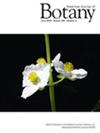Tree height and not climate influences intraspecific variations in wood parenchyma fractions of angiosperm species in a mountain forest of eastern China
Abstract
Premise
Parenchyma is an important cell type in the secondary xylem of angiosperm trees, with considerable variability in its abundance. However, the functional significance of these variations and their roles in plant ecological strategies is poorly understood at the inter- and intraspecific levels.
Methods
For this study, fractions of axial parenchyma cells (AP) and ray parenchyma cells (RP) in xylem tissue were quantified for 156 individuals of 45 tree species along an elevational gradient from 600 to 1600 m a.s.l. in eastern China. Environmental factors and height of sampled trees at each sampling site were also measured. Linear mixed models were employed to assess the relative extent of both intraspecific and interspecific variations in parenchyma cells in xylem tissue fractions and to identify intraspecific variations along environmental gradients (e.g., temperature and humidity) and tree heights.
Results
Interspecific variations explained the large diversity in AP fractions. Conversely, intraspecific variations accounted for ~50% of the overall variations in RP fractions. Further, intraspecific variations in the RP and the total AP and RP fractions exhibited negative correlations with tree heights but showed no significant relationship with climate.
Conclusions
Intraspecific variations in parenchyma cells in xylem tissue fractions are not necessarily an adaptation or acclimation to changes in the environment but are coordinated with tree heights.




 求助内容:
求助内容: 应助结果提醒方式:
应助结果提醒方式:


